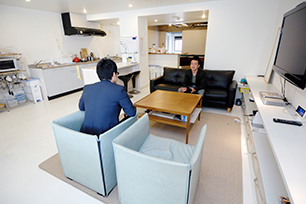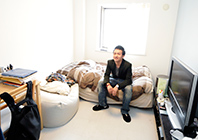The Life of a Keio Student (2)
Share Place Yomiuri Land (Kawasaki, Kanagawa Prefecture): Learning from fellow housemates
Recently a popular choice among young people in Japan, "share houses" come in several different types, from small groups of people renting a house together to purpose-built or renovated buildings with individual rooms and communal areas. Yosuke Ueki, from Fukuoka prefecture, lives at Share Place Yomiuri Land, one of the latter. A refurbished company dormitory, Share Place Yomiuri Land attracts many young working people in their 20s and 30s.

Fourth-year, Faculty of Policy Management


——Why did you choose to live in a share house?
Yosuke: Initially I lived in a one-room flat near Shonan Fujisawa Campus. I was searching online for fun places to live when I found Share Place Yomiuri. I thought a share house would be a good place to live because I wanted to interact with other people even after I went home. If you live in a normal apartment building, a lot of the time you don't get much further than exchanging the odd greeting with your neighbors. I also wanted to be able to spend time with people other than fellow students. This share house has 44 rooms, but I'm the only student living here.
——What do you like about living in a shared house?
Yosuke: The rooms are fitted with furniture, a refrigerator, air-conditioning, and Internet access, so moving in was very easy. There is no large shared bathroom, but there are showers for communal use. There is also a shared kitchen, complete with cooking equipment and utensils. I've learned a lot from chatting to my housemates over a cup of tea or dinner. They work in a variety of different fields, so I have learned a lot about the world of work, which has really broadened my horizons. When friends move out or new people move in, we often get together to cook a meal and socialize. One of my housemates owns a telescope and organized a star-gazing party, so we could watch the lunar eclipse and meteor shower together. Living with all kinds of different people under the same roof can be a lot of fun, but at the same time it encourages you to be sensitive and respectful to others, whether that means greeting your housemates politely or keeping communal areas clean. I think it is a good idea to experience living with other people while you are still a student.
——Approximately how much is your rent?
Yosuke: The monthly rent is 64,000 yen, including utility fees and Internet access. There is an additional deposit of 50,000 yen to pay when moving in.
Homes away from home
Third-year Faculty of Pharmacy student from Aichi Prefecture living in a privately-run women's student dormitory
Period of residence: Two years. Monthly rent: around 100,000 yen including three meals a day and utilities. Individual rooms. Shared bathroom, toilet, kitchen, study room, and piano room (for an additional fee).
"I'm very happy here. We are free to eat our meals when we like and the food is really good; I've even put on a little weight. Our rooms are cleaned once every four months and there is no need to do housework. We have a 23:00 curfew, so I have to leave in the middle of the occasional party with friends, but I think it's a reasonable time for a curfew. I usually study in the university library, in the study room at the dormitory, or in my own room. My elder sister is a fifth-year at the Faculty of Pharmacy and lives here too, so I don't get lonely. My mother also stays in the guest room (for an additional fee) when she visits Tokyo."
Third-year Faculty of Business and Commerce student from Osaka Prefecture living at male student dormitory "Wakeijuku"
A complex of dormitories run by the Wakeijuku Foundation for male university students. Period of residence: Two years. Monthly rent: 90,000 yen including two meals and utilities. Shared bathroom, toilet, and kitchen.
"There are six dormitories in the Wakeijuku community, housing a total of 580 students. The annual inter-dormitory sports festival, held in October, creates a lot of excitement and a sense of unity in each dormitory; it can be a very emotional event. It's fun to chat with students of all different ages from other universities, and I've learned how to better respect and communicate with others, especially those older than me. On weekends, we usually play sports at the sports field outside the dorm. I email or phone my parents once a month and I visit home during the vacations three times a year."
Student life in figures: Students living away from home
(Second- to fourth-year students)
More than 70% of Keio students are currently from Tokyo, Kanagawa Prefecture, Saitama Prefecture, and Chiba Prefecture. In recent years, the number of students from regional areas has experienced a slight decrease. Around 30% of students do not live at home when school is in session.
Of students living away from home, just under 70% of students choose to live in Kanagawa Prefecture while 30% call Tokyo their new home. Those studying at Hiyoshi or Yagami Campus tend to live between the two closest stations to Hiyoshi Station on the Toyoko line--Motosumiyoshi and Tsunashima--while many of those at Shonan Fujisawa Campus live near Shonandai Station. In Tokyo, many students live near Mita Campus and in Omori Nishi, where there is a student dormitory (Figures are based on second to fourth-year students; first year students were not surveyed). The higher the year of the student, the more likely they are to live in Tokyo.
The percentage of students living away from home is over 40% among students studying at Shonan Fujisawa Campus, at the Faculty of Environment and Information Studies, Faculty of Policy Management, and Faculty of Nursing and Medical Care, while only around 25% of students at the Faculties of Letters, Economics, Law, Medicine, and Pharmacy live away from home.
*This article appeared in the 2013 summer edition (No.279) of “Juku”.
*Position titles, etc., are those at the time of publishing.
